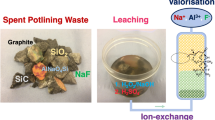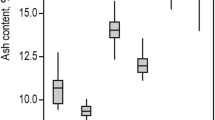Abstract
The clean-up of the Fukushima Daiichi site, after the March 2011 earthquake and tsunami, continues to generate large amounts of spent adsorbents. These adsorbents need to be disposed of permanently in a low temperature immobilisation process to avoid volatilising radioactive Cs and Sr species. To this end an immobilisation process with a maximum temperature of 600 °C was developed by sintering model waste with glass frit to form a dense Glass Composite Material (GCM) wasteform. A zeolitic model wasteform, chabazite, was sintered with a lead borosilicate glass composition at a maximum temperature of 600 °C. The sintering process was optimised with various thermal treatment steps to ensure that volatile species, aqueous or otherwise, were released before full sintering to yield a dense final wasteform. With this process dense wasteforms of up to 40 wt. % chabazite have been achieved.
Similar content being viewed by others

References
Division of Nuclear Installation Safety, Mission Report - IAEA International fact finding expert mission of the Fukushima Dai-ichi NPP accident following the Great East Japan Earthquake and Tsunami. 2011, IAEA: Vienna, Austria.
M.H. Langowski, J.G. Darab, and P.A. Smith, Volatility Literature of Chlorine, Iodine, Cesium, Strontium, Technetium and Rhenium; Technetium and Rhenium Volatility Testing, Pacific Northwest National Laboratory, Editor. 1996, US Department of Energy,: Oak Ridge, USA.
D.M. McPherson, B.W. Bowan, and L.D. Pye. The Dissolution of Zeolitic Compounds in Borosilicate Glass Melts. in International Congress on Glass. 1986. New Delhi, India.
A.A. Digeos, J.A. Valdez, K.E. Sickafus, S. Atiq, R.W. Grimes, and A.R. Boccaccini, Glass Matrix/Pyrochlore Phase Composites for Nuclear Wastes Encapsulation. Journal of Materials Science, 2003. 38(8): p. 1597–1604.
K. Raj and C.P. Kaushik, Glass Matrices for Vitrification and Radioactive Waste, in International Seminar on Science and Technology of Glass Materials. 2009, Institute of Physics: UK.
V.S. Yalmali, D.S. Deshingkar, and P.K. Wattal, Chemical Durability of Lead Borosilicate Glass Matrix Under Simulated Geological Conditions, B.A.R.C. Back-End Technology Development Division, Editor. 2002, Government of India: Mumbai, India.
W.E. Lee, M.I. Ojovan, M.C. Stennett, N.C. Hyatt, Immobilisation of Radioactive Waste in Glasses, Glass Composite Materials and Ceramics. Advances in Applied Ceramics, 2006. 105: p. 3–12.
H. Kamizono, S. Kikkawa, S. Tashiro, and H. Nakamura, Volatilization of Cesium from Nuclear Waste Glass in a Canister. Nuclear Technology, 1986. 72(1): p. 84–88.
S. Le Caër, Water Radiolysis: Influence of Oxide Surfaces on H2Production under Ionizing Radiation. Water, 2011. 3(1): p. 235.
R.K. Chinnam, S. Molinaro, E. Bernardo, and A.R. Boccaccini, Borosilicate Glass Foams from Glass Packaging Residues, in Ceramic Transactions. 2014. p. 205–210.
Author information
Authors and Affiliations
Rights and permissions
About this article
Cite this article
Pletser, D., Chinnam, R.K., Kamoshida, M. et al. Immobilisation process for contaminated zeolitic ion exchangers from Fukushima. MRS Advances 1, 4089–4094 (2016). https://doi.org/10.1557/adv.2017.194
Published:
Issue Date:
DOI: https://doi.org/10.1557/adv.2017.194



